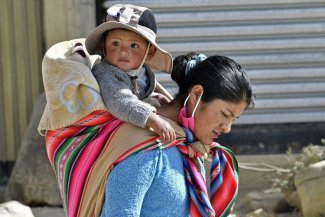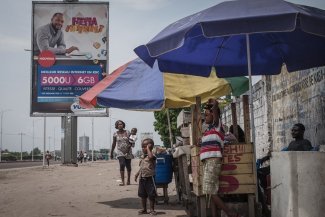“In Bolivia, most of the population [concentrated in urban areas] that accesses an internet connection does so through mobile phones”. The infrastructure gaps are also, therefore, down to the telephone companies, which focus on connectivity in the big cities, while neglecting rural areas where “you’re lucky if you have access to a telephone provider”. In the picture, low income with mostly Aymara Indigenous residents, Ch’uwa Uma neighbourhood (La Paza, Bolivia), 2019.
The digital divide between rich and poor countries is still “staggeringly wide”, concluded a United Nations conference in March. For at least two-thirds of the world’s population, internet access remains out of reach, especially in countries in the Global South, such as Bolivia, where the digital divide is still very marked.
Although 95 per cent of the world’s population has access to a mobile broadband network, and 3G or 4G technology, at least 390 million people remain unconnected.
In Bolivia, “progress has been made with the infrastructure over the last 10 years. We’ve jumped from 5,000 kilometres of fibre optics to more than 27,000. It’s a significant leap in terms of fibre optic connectivity, which is the best, not just for basic things but also for making productive use of the internet,” says Eliana Quiroz, founder and member of Fundación Internet Bolivia.
The expert nonetheless points out that the progress made in terms of infrastructure contrasts with the lack of policies specifically aimed at promoting internet use and digital skills, or digital literacy policies.
“One example is the [Covid-19] pandemic. The huge lack of digital skills in the education sector (...) ended up creating a bigger gap,” says Quiroz, adding that the impact was greater in rural areas. It is estimated that 70 per cent of internet connections were concentrated in urban areas during the pandemic, versus 21 per cent in rural areas.
Education and the urban-rural digital divide
More than a decade has gone by since Bolivia enacted the General Law on Telecommunications, Information and Communication Technologies, which sets out the right to universal and equitable access to telecommunications services and information and communication technologies, but the challenge of reducing digital exclusion among rural populations remains pending.
“In Bolivia, most of the population [concentrated in urban areas] that accesses an internet connection does so through mobile phones,” says Verónica Rocha, communications officer at Oxfam Bolivia. The infrastructure gaps are also, therefore, down to the telephone companies, which focus on connectivity in the big cities, while neglecting rural areas where “you’re lucky if you have access to a telephone provider”.
“It’s the logic of the market [...]. If there is a demographic that doesn’t offer the chance of making a profit, that is, if very few people are going to use the service, then it’s not worth it and so the [telephone] companies don’t go there,” says Quiroz. There’s a “striking difference” in the number of devices “in a house in a rural area and a house in an urban area,” adds Rocha.
Another factor fuelling the urban-rural digital divide is household income, as access to a good internet connection is relatively expensive in Bolivia.
According to a report by Fundación Internet Bolivia, 9 out of 10 high-income households had a connection at home during the pandemic, compared to 1 out of 10 lower-income households. And while 63 per cent of private schools (with students from affluent families) were able to access virtual classes, only 15 per cent of public schools (with students from low-income families) were able to do so.
“When the pandemic came along and the digital component became a vehicle for education, it made things even more difficult because not only were the students less able to take part, but the families [parents] were also in turmoil because they weren’t able to pass on any [technological] knowledge, as they didn’t have it, either because of the generation gap or because they’re not familiar with digital tools,” Rocha explains.
These digital divides exposed during the pandemic made education one of the main concerns expressed by those interviewed.
Amid all the changes brought about by technological advances, the structural inequalities in education constitute a threat to the rights of the new generations that not only impacts on their present but will also affect their future lives, be it in terms of their job prospects or life opportunities, if the connectivity issue is not resolved.
And although the right to education in the Andean country is largely guaranteed when it comes to access, “the problems begin when it comes to taking part in the educational process,” Rocha points out, because this is where the inequalities, generally linked to students’ socioeconomic situation and historical or origin-related gaps, are accentuated.
As Quiroz points out, one reality seen during the pandemic were the difficulties that the digital divide created for rural families, leaving many “having to choose which son or daughter – generally not the daughter but the son – was going to continue studying and who was not,” undermining a series of rights and in turn highlighting the fact that internet access has become a key “enabler of other rights”.
Telework and inclusion
“There are not many studies on labour rights in Bolivia [...] but what the pandemic has done is to make people aware that there are several ways to use the internet to improve job opportunities, but they are still largely under-utilised,” says Quiroz with regard to telework, which has gone from being a temporary solution to a permanent one for companies in many countries.
The issue now, say the experts, is that the changes in working arrangements mean that the challenges are not only about infrastructure, connectivity and skills but also about the changes needed in the labour laws, and how to address matters such as workspaces, remote connections or the minimum conditions required for workers to do their jobs.
A joint study on telework in Bolivia by the Inter-American Development Bank (IDB) and the United Nations Development Programme (UNDP) revealed that the lack of a good internet connection and the necessary equipment – computers and mobile phones – were among the obstacles to teleworking during the pandemic, and these barriers have not yet been removed.
On the subject of difficulties not yet tackled in Bolivia such as work-life balance and the right to disconnect, Quiroz adds that “the issue of working hours has become very complicated, because you can easily find yourself writing at seven in the morning and still be there writing at 10 or 11 o’clock at night, or having a meeting, especially if you work in a context that is not only national”.
Another issue to consider when working to close the gap is the level of digital violence to which men, women and LGBTQI+ people are unequally exposed: “When it comes to hate speech, disinformation or politically critical moments, for example, women tend to be the targets of greater violence,” says Rocha.
According to Quiroz, the fact that women and LGBTQI+ people suffer the most attacks on their rights to express themselves freely in digital spaces tends to discourage them from using the internet to the full and leads to a form of self-censorship that impacts on their technological knowledge, development and inclusion.
Measures to mitigate the digital divide
Both experts agree that the issue of digital violence and harassment against women and LGBTQI+ people in Bolivia is a problem that needs to be addressed with a digital security and inclusion policy that supports the exercise of their rights and their civic, political and social participation, as well as their development in the labour market, enabling them to achieve economic independence in a country that is very conservative.
In a world that is increasingly virtual and impacted by artificial intelligence (AI), there are more questions than answers about what lies ahead in our ever-more connected societies and what countries like Bolivia will have to adapt to.
According to the experts interviewed, what the country needs to do to prepare for the digital future is to develop a “technology policy” that guarantees more efficient and fairer regulation of the internet and new technologies.
But there is also an urgent need for policies aimed at improving technological skills, mainly prioritising “the most vulnerable groups, who tend to be those who lose the most in technological contexts”.
“I think we still have a long way to go. We need greater and more serious digitalisation. We also need to look at the complexity of digitalisation, which is not only about connecting but is also about connecting without affecting human rights, which is a global debate. It’s not just about putting infrastructure in place so that people can connect and become passive consumers; it’s about having critical connectivity,” concludes Quiroz.













